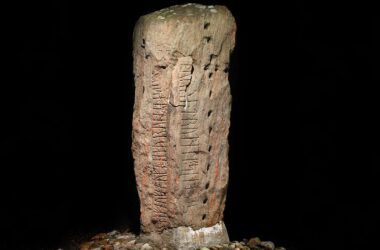New Jersey’s colonial banknote from 1763.Pictures from the Smith Collection / Gado / Getty Images
Benjamin Franklin, a founding father of the United States, reportedly pioneered anti-counterfeiting techniques in paper currency decades before they became standard practise. Over 600 banknotes created by Franklin and his companions between 1709 and 1790 were studied by researchers from the University of Notre Dame in Indiana. They found that Franklin began using indigo-dyed blue fibres and threads in paper money as early as 1739. This was likely done to deter counterfeiting. This occurred almost a century before paper producer Zenas Marshall Crane is commonly credited with pioneering these techniques. The investigation also uncovered that Franklin printed currency using a natural graphite-based black ink, while other printers and counterfeiters of the time used inks made from burning vegetable oils or charring bones.
According to Khachatur Manukyan, the study’s primary investigator, these colored-fiber printing methods have been employed in the production of U.S. federal dollars and other currencies across the world.
The study group looked at what went into Franklin’s printing techniques by analysing the inks, fibres, and paper.
Banknotes were analysed for their physical composition using electron microscopes. They had to analyse samples smaller than a human hair so as not to damage the priceless artefacts.
The investigation also showed that as early as 1754, Franklin added muscovite flakes to the paper pulp to make the banknotes last longer.
Farley Grubb, a professor of economics at the University of Delaware, argues that these discoveries add to Franklin’s scientific legacy in a practical sense. Grubb is still dubious, however, as to whether or not these developments in ink and paper were intended to counteract forgery. He elaborates on how, in colonial America, counterfeit coins were far more common than paper bills. Large-scale attempts to counterfeit paper currency were unusual at the time. During the American Revolutionary War, the British attempted the most serious case of counterfeiting by mass producing copies of Continental dollars issued by the Continental Congress. Fortunately, Congress was able to repeal and replace the offending legislation.
FAQs
Question 1: When did Benjamin Franklin begin using anti-counterfeiting techniques in paper money?
Answer: Benjamin Franklin started using indigo-dyed blue fibers and threads in paper money as early as 1739, decades before they became standard practice.
Question 2: Who studied the banknotes created by Benjamin Franklin and his companions?
Answer: Researchers from the University of Notre Dame in Indiana studied over 600 banknotes created by Benjamin Franklin and his companions between 1709 and 1790.
Question 3: What ink did Benjamin Franklin use in printing currency?
Answer: Benjamin Franklin used a natural graphite-based black ink in printing currency, while other printers and counterfeiters of the time used inks made from burning vegetable oils or charring bones.
Question 4: What did the investigation reveal about Franklin’s printing techniques?
Answer: The investigation analyzed the inks, fibers, and paper of the banknotes using electron microscopes. It also showed that Franklin added muscovite flakes to the paper pulp to enhance the banknotes’ durability.
Question 5: Was Franklin’s use of colored fibers and ink intended to counteract forgery?
Answer: While there is debate about Franklin’s intentions, these colored-fiber printing methods have been adopted in the production of U.S. federal dollars and other currencies worldwide, highlighting their effectiveness in anti-counterfeiting.







